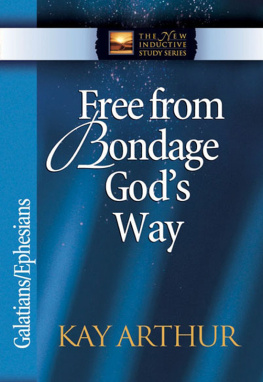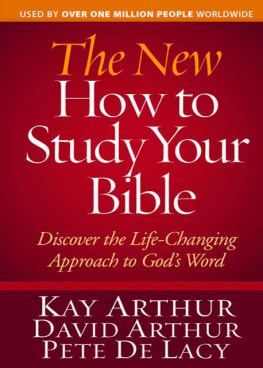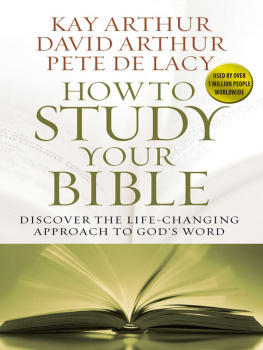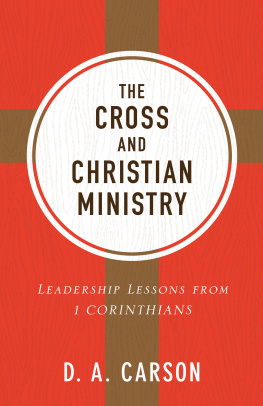
Gods
Answers for
Relationships
and Passions
KAY ARTHUR

HARVEST HOUSEPUBLISHERS
EUGENE, OREGON
Except where otherwise indicated, all Scripture quotations in this book are taken from the New American Standard Bible, 1960, 1962, 1963, 1968, 1971, 1972, 1973, 1975, 1977, 1995 by The Lockman Foundation. Used by permission.
Verses marked KJV are taken from the King James Version of the Bible.
Except where otherwise indicated, all maps and charts in this book, as well as the How to Get Started portion of the introductory material, have been adapted and condensed from The New Inductive Study Bible, Copyright 2000 by Precept Ministries International.
Cover by Koechel Peterson & Associates, Minneapolis, Minnesota
The New Inductive Study Series
GODS ANSWERS FOR RELATIONSHIPS AND PASSIONS
Copyright 1995 by Precept Ministries International
Published by Harvest House Publishers
Eugene, Oregon 97402
Library of Congress Cataloging-in-Publication Data
Arthur, Kay, 1933
Gods answers for relationships and passions / Kay Arthur.
p. cm. (The new inductive study series)
ISBN 0-7369-0801-3
1. Bible. N.T. CorinthiansStudy and teaching. 2. Bible. N.T. CorinthiansCriticism, interpretation, etc. I. Title. II. Series: Arthur, Kay, 1933
The new inductive study series.
BS2675.5.A72 1995
All rights reserved. No part of this publication may be reproduced, stored in a retrieval system, or transmitted in any form or by any meanselectronic, mechanical, digital, photocopy, recording, or any otherexcept for brief quotations in printed reviews, without the prior permission of the publisher.
Printed in the United States of America.
02 03 04 05 06 07 08 09 10 / BP-MS / 10 9 8 7 6 5 4 3 2 1
CONTENTS


It may be tempting to skip this part of the book and rush to the beginning of your study, but dont! I can relate! But in this case, this short section contains invaluable help for understanding what you will do in the study. These instructions are an integral part of getting started, and they will help you greatly!
FIRST
As you study the books of 1 and 2 Corinthians, you will need four things in addition to this book:
1. A Bible that you are willing to mark in. Marking is essential because it is an integral part of the learning process and will help you remember and retain what you learned. An ideal Bible for this purpose is The New Inductive Study Bible (NISB). The NISB, available in the New American Standard Version, comes in a single-column text format with larger, easy-to-read type and is ideal for marking. The page margins are wide and blank for note-taking.
The NISB is unique among all study Bibles in that it has instructions for studying each book of the Bible, but it does not contain any commentary of the text. The NISB isnt compiled from any particular theological stance since its purpose is to teach you how to discern truth for yourself through the inductive method of study. Inductive Bible study simply means that the Bible itself is the primary source for study. (The various charts and maps that you will find in this study guide are taken from the NISB.) Whatever Bible you use, just know you will need to mark in it, which brings us to the second item you will need.
2. A fine-point, four-color ballpoint pen or various colored fine-point pens for writing in your Bible. Micron pens are the best for this purpose. Office supply stores should have these.
3. Colored pencils or an eight-color Pentel pencil.
4. A composition notebook or a loose-leaf notebook for working on your assignments and recording your insights.
SECOND
Though you will be given specific instructions for each days study, there are basic things youll want to look for and do as you study each book chapter by chapter. Let me list them for you. Read through the list but dont be overwhelmed. Eventually, each step will become a habit.
1. As you read each chapter, train yourself to ask the 5 Ws and an H questions: who, what, when, where, why, and how. Asking questions like these helps you see exactly what the Word of God is saying. When you interrogate the text with the 5 Ws and an H, ask questions like this:
a. What is the chapter about?
b. Who are the main characters?
c. When does this event or teaching take place?
d. Where does this happen?
e. Why is this being done or said?
f. How did it happen?
2. There are certain key words that you will want to mark in a special way in the text of your Bible. This is the purpose of the colored pencils and the colored pen. Developing the habit of marking your Bible in this way will make a significant difference in the way you study and in how much you remember.
A key word is an important word that is used by the author repeatedly in order to convey his message to his reader. Certain key words will show up throughout the book as a whole, while other key words will be concentrated in certain chapters or segments of the book. You will want to mark key words and their pronouns (he, his, she, her, it, we, they, us, our, you, them, their) as well as any synonyms in a distinguishable color or way.
For instance, one of the key words in 1 Corinthians is gospel. I put a hot-pink megaphone around the word  and then color it in with green. I use the megaphone because God tells us we are to proclaim the gospel.
and then color it in with green. I use the megaphone because God tells us we are to proclaim the gospel.
You need to devise a color-coding system for key words so that when you look at a page of your Bible, you will instantly see where a particular word is used. When you start marking key words in various colors and symbols, it is easy to forget how you are marking certain words. You may wish to use the bottom portion of the perforated card in the back of this book to write the key words on. Mark the words the way you plan to mark them in your Bible and then use the card as a bookmark.
In 1 Corinthians you will use your bookmark to track certain words that are key to the book. Additionally, I will give you other key words that are used only in specific passages. In 2 Corinthians the key words are more specific to chapters or passages than they are relevant to the entire book, so I will give you the key words as you go through the study.
I mark the word power the same way throughout my New Inductive Study Bible. I color it red and draw a stick of dynamite around it:  . And references to the devil and his cohorts stand out because I mark these with a red pitchfork:
. And references to the devil and his cohorts stand out because I mark these with a red pitchfork:  . I color the word wisdom pink and then underline it in blue. When I mark boast, I also color it pink, but I box it with green.
. I color the word wisdom pink and then underline it in blue. When I mark boast, I also color it pink, but I box it with green.
Marking words for easy identification can be done using colors, symbols, or a combination of colors and symbols. However, colors are easier to distinguish than symbols. If I use symbols, I keep them very simple. For example, I color
Next page

















 and then color it in with green. I use the megaphone because God tells us we are to proclaim the gospel.
and then color it in with green. I use the megaphone because God tells us we are to proclaim the gospel. . And references to the devil and his cohorts stand out because I mark these with a red pitchfork:
. And references to the devil and his cohorts stand out because I mark these with a red pitchfork:  . I color the word wisdom pink and then underline it in blue. When I mark boast, I also color it pink, but I box it with green.
. I color the word wisdom pink and then underline it in blue. When I mark boast, I also color it pink, but I box it with green.